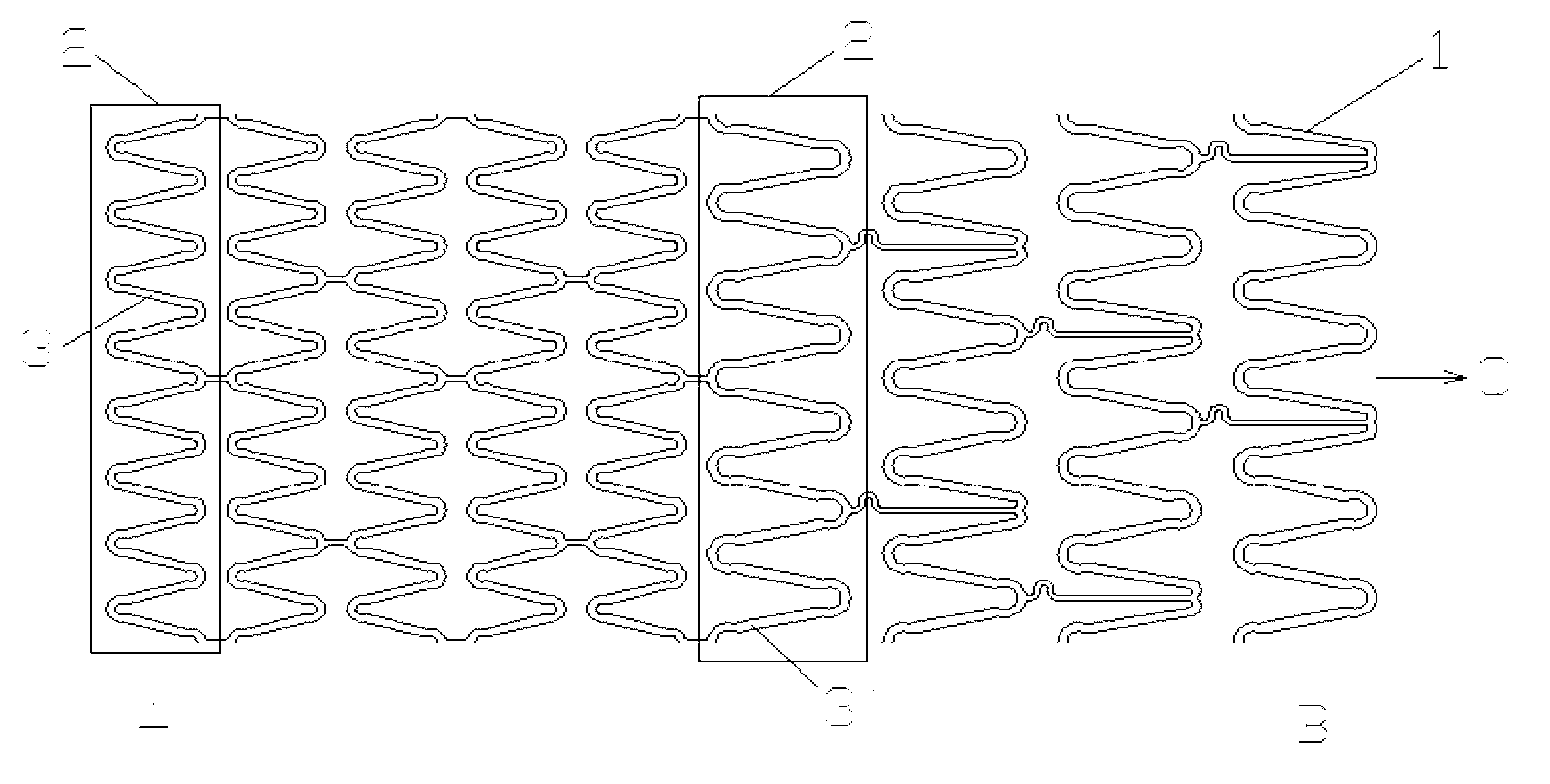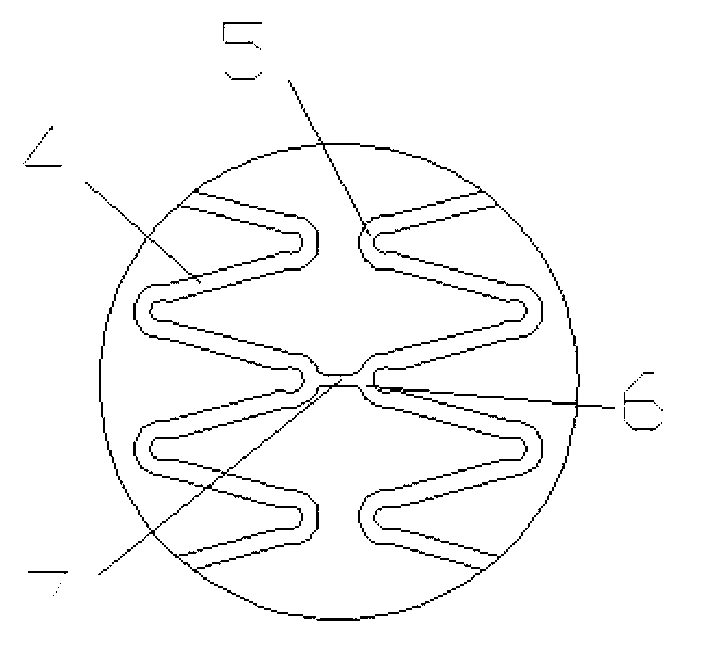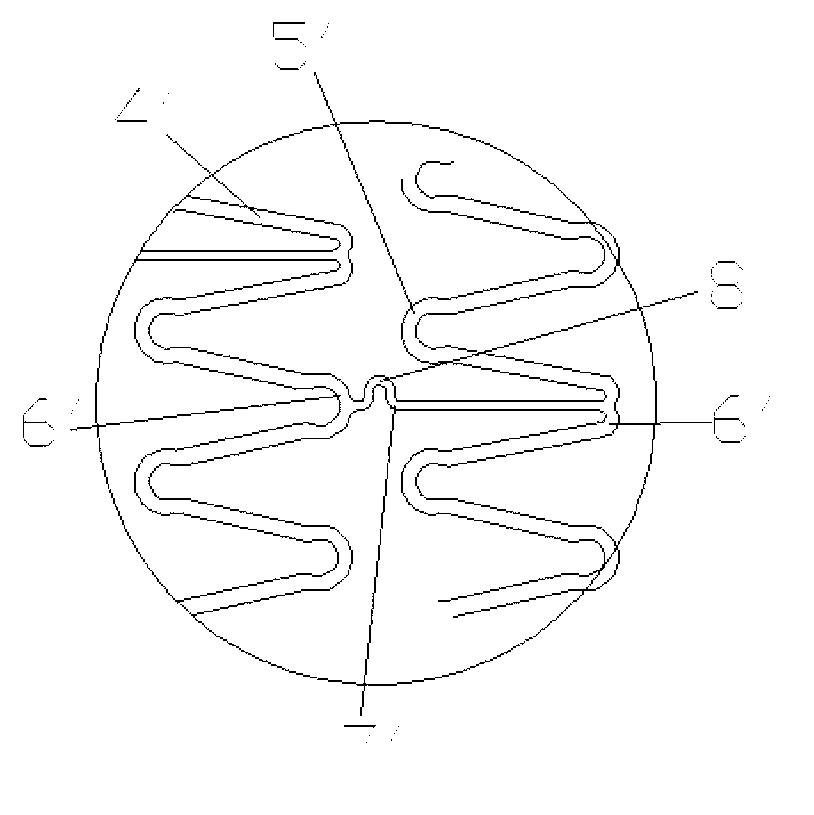Vertebral artery stent
A vertebral artery and annular unit technology, applied in the field of vertebral artery stents, can solve problems such as incompatibility with the vertebral-basilar artery system, and achieve the effects of maintaining arterial patency, maintaining support strength, and good flexibility
- Summary
- Abstract
- Description
- Claims
- Application Information
AI Technical Summary
Problems solved by technology
Method used
Image
Examples
Embodiment
[0035] like figure 1 As shown, along the axial direction of the stent, the U-shaped structures 3 and 3' with one end open are circumferentially arranged around the central axis C of the stent 1, forming denser type-1 annular units 2 and relatively sparse type-II annular units 2' axial arrangement, U-shaped structures 2 and 2' are composed of straight line segments 4 and 4' and arc segments 5 and 5' or 6 and 6', U-shaped structures 3 and 3' are connected by connecting ribs 7 and 7' A tubular structure is formed, which can expand and deform from inside to outside.
[0036] A plurality of U-shaped structures 2 of the first type are connected in the circumferential direction to form a denser annular unit 3 of the first type; a plurality of U-shaped structures of the second type 2' are connected in the circumferential direction to form a ring-shaped unit of the second type 3' which is sparser, and, The denser one-type annular unit 3 is arranged at the proximal end of the blood...
Embodiment 1
[0074] Embodiment one: if figure 1 , figure 2 , image 3 shown.
[0075] The technical solution provided by the invention is: a conical vertebral artery stent ( figure 1 ), characterized in that: the vertebral artery stent (1) includes a denser first-class annular unit (2) and a relatively sparse second-type annular unit (2′); the denser first-class annular unit (2) and the sparser second-type annular units (2′) are respectively arranged at the proximal end (A) and distal end (B) of the vertebral artery to form a tubular structure; the denser first-type annular units (2) It is composed of axially (C) symmetrical U-shaped structures (3) connected in series, and part of the U-shaped structures (3) adjacent to the corresponding circular arcs (6) are connected by short straight rods (7); The sparser second-type annular units (2') are connected in series by axial (C) asymmetric U-shaped structures (3'), and some of the U-shaped structures (3') adjacent to the correspon...
Embodiment 2
[0092] Embodiment two: if Figure 4 , Figure 5 shown.
[0093] The scaffold (1) of the present invention includes a denser type of cyclic unit (2) and a relatively sparse second type of cyclic unit (2′); the denser type of cyclic unit (2) and the described The sparser type II annular units (2′) are respectively arranged at the proximal end (A) and the distal end (B) of the vertebral artery to form a tubular structure; the denser type II annular units (2) consist of axial (C) The symmetrical U-shaped structures (3) are connected in series, and the corresponding circular arcs (6) adjacent to a part of the U-shaped structures (3) are connected by short straight rods (7); the sparser two The quasi-ring unit (2') is connected in series by axially (C) symmetrical U-shaped structures (3'), and the corresponding arcs (6') adjacent to some U-shaped structures (3') are formed by " S " shape connecting rib (7 ') links to each other.
[0094] Others are the same as in Example ...
PUM
 Login to View More
Login to View More Abstract
Description
Claims
Application Information
 Login to View More
Login to View More - R&D
- Intellectual Property
- Life Sciences
- Materials
- Tech Scout
- Unparalleled Data Quality
- Higher Quality Content
- 60% Fewer Hallucinations
Browse by: Latest US Patents, China's latest patents, Technical Efficacy Thesaurus, Application Domain, Technology Topic, Popular Technical Reports.
© 2025 PatSnap. All rights reserved.Legal|Privacy policy|Modern Slavery Act Transparency Statement|Sitemap|About US| Contact US: help@patsnap.com



